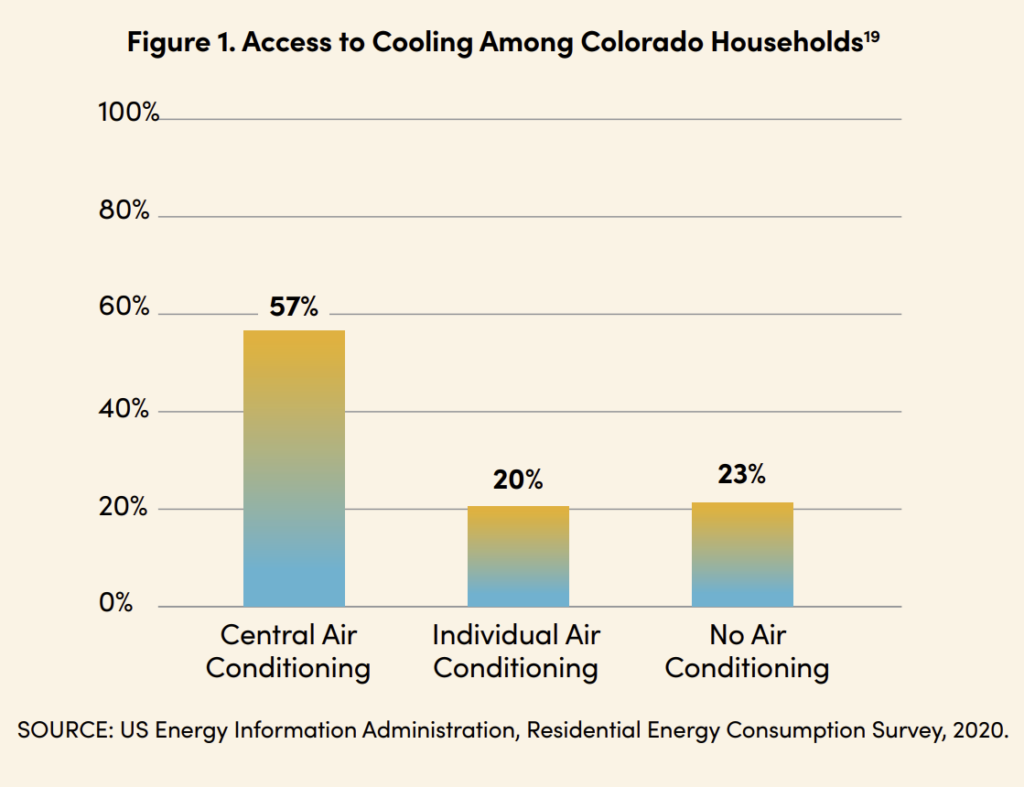
The Top Four Ways Colorado Can Secure Clean and Affordable Cooling
For state and local government agencies considering ways to expand equitable access to cooling, the Inflation Reduction Act (IRA) provides significant opportunities to leverage federal funding.
While last year’s summer heat may feel like a distant memory for most of the Northern Hemisphere, 2023 was officially the hottest year on record. If trends continue, 2024 will be even hotter. Like many places around the United States and the globe, Colorado felt the sweltering effects and broke hundreds of daily high-temperature records. As the state’s temperatures are estimated to rise 2.5°F –5°F more by 2050, state and local government agencies play an outsized role in securing better access to cooling for all Coloradans. Efficient and affordable air conditioning is especially important for low-income households, renters, and communities of color, who are most impacted by extreme heat and high energy costs.
A new report, Merciless Heat: How State and Local Lawmakers can Protect At-Risk Households, co-authored by RMI and Healthy Air and Water Colorado, lays out the steps that policymakers can take now to protect Coloradans from extreme heat, while simultaneously advancing the state’s climate and equity goals. Below are its top four findings.
1. Right to Cooling: State and Local Policy Levers
States, cities, and counties have a variety of policy options available to protect people from the effects of extreme heat and reduce climate-warming emissions. These options include:
- Codes and Standards: In already-hot states like Arizona and Nevada, state laws define air conditioning as an essential service landlords must maintain. A maximum indoor temperature is another increasingly common mechanism to protect residents from extreme heat. Cities and counties in Arizona, California, Maryland, Nevada, and Texas have adopted a variety of codes requiring housing to have cooling equipment capable of keeping the temperature below an established threshold. Further, modern building codes require new homes to have better insulation that lowers energy use and improves resiliency. Statewide standards can also help make sure installed cooling equipment is effective and efficient.
- Funding and Financing: States and municipalities across the country can use federal and state rebates, tax incentives, and low- and no-interest financing to expand access to cooling, especially for low-income households. For instance, both the State of Colorado and the City and County of Denver offer incentives for cooling equipment, with the state tax credit covering up to $3,000 for a heat pump and the Denver rebates providing up to $3,500.
- Utility Mechanisms: Once households have air conditioning, it is crucial to ensure they can afford their utility bills in the face of weather extremes. In Colorado, House Bill 22-1018 prevents regulated electric utilities from disconnecting customers for nonpayment during major heat events.
2. Designing Cooling Policies for Success
RMI and HAWC’s new report examines important policy design considerations for successful implementation. For instance, modern heat pumps offer states and cities a two-in-one climate tech solution to increase cooling access and provide efficient heating when temperatures take a dip.
Compared to a conventional central AC unit, a heat pump can cool indoor spaces effectively while reducing peak electricity usage by over 10 percent. Plus, replacing a central AC unit with a heat pump at the end of the AC’s useful life can save Colorado households money up front, with up to $10,000 in federal heat pump incentives for low- and moderate-income households. RMI analysis shows that this swap-out would also reduce home carbon emissions by approximately one-third compared to a one-way central AC unit and gas furnace combination.
Cooling incentives and standards should promote heat pumps to maximize energy bill savings for consumers, support a resilient electric grid, and minimize climate pollution from burning fossil fuels. Further, adopting electric rates specifically designed to keep utility bills affordable as households go all-electric supports a just transition by helping to alleviate energy costs, especially for low-income customers.
At the state level, Colorado has an immediate opportunity to pursue policies that support efficient cooling through its Greenhouse Gas Pollution Reduction Roadmap 2.0, which will define Colorado’s pathway to cutting carbon emissions to 50 percent of 2005 levels by 2030. Options include requiring or incentivizing heat pumps in all new construction through the state energy code. Further, Colorado has an opportunity to require heat pump replacements for air conditioning systems at the end of their useful life, effective starting in 2027.
3. Prioritizing Tenant Protection in Unison with Cooling Access
State and local programs that fund, require, or incentivize cooling upgrades should include strong tenant protections to avoid risk of displacement for renters. For example, new cooling policies can require property owners who receive cooling incentives to sign binding affordability agreements that restrict rent increases for several years following upgrades. The federal Home Energy Rebates include a similar provision, barring building owners who receive rebates from raising rents or evicting tenants (to gain higher rents) for two years.
Successful cooling policies that protect tenants from displacement may also require coordinated code and standard updates. Oregon’s Senate Bill (SB) 1536 (2022) provides a cautionary tale. SB 1536 codifies tenants’ right to install their own cooling devices, yet Oregon tenants who installed window AC units following the bill’s passage reported receiving eviction notices because the installations violated fire codes and safety standards. Coordinated updates to fire codes and health and safety standards may be necessary to ensure that tenants can safely exercise their right to cooling.
4. The Inflation Reduction Act: A New Opportunity to Fund Cooling
For state and local government agencies considering ways to expand equitable access to cooling, the Inflation Reduction Act (IRA) provides significant opportunities to leverage federal funding. A variety of federal incentives, such as the Home Energy Rebates and the Energy Efficient Home Improvement Credit, are expected to make heat pumps more accessible by providing up to $8,000 in rebates and $2,000 in tax credits. State and local government entities can also leverage other IRA funding, like the Climate Pollution Reduction Grants, to further support equitable cooling policies for low-income residents.
It may be the middle of winter, but the heat will come. The time for policymakers to act is now. Read the full report to learn how Colorado and other jurisdictions across the country can seize this opportunity to protect residents’ right to efficient and affordable cooling.

